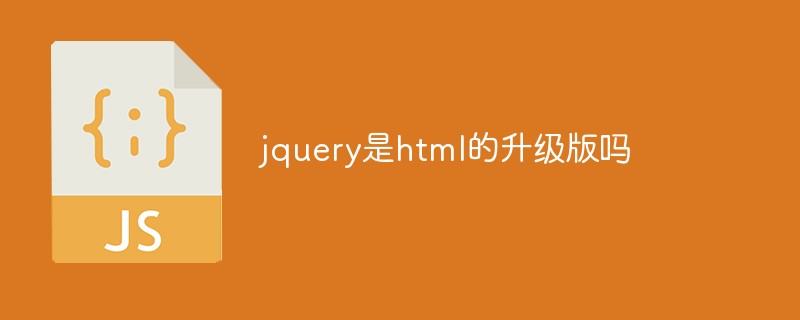Home >Web Front-end >Front-end Q&A >Is jquery an upgraded version of html?
jquery is not an upgraded version of html. jquery is a set of JavaScript libraries, and html is a hypertext markup language. There is no direct upgrade or downgrade relationship between the two; jquery simplifies the use of JavaScript for web page special effects development. Complexity provides the automation of common tasks and the simplification of complex tasks, while HTML is used to associate text, graphics and other information media in text through hyperlink methods.

The operating environment of this tutorial: windows10 system, jquery3.4.1 version, Dell G3 computer.
jquery is not an upgraded version of html
jquery
jQuery is a set of JavaScript libraries that simplify some of the complexities of using JavaScript to develop web page special effects, providing automation of common tasks and simplification of complex tasks
JQuery is actually An extension to existing JavaScript, it is very lightweight, about 32KB after compression, and is compatible with various browsers, so you can easily add special effects suitable for multiple browsers. jQuery was originally created by American John Resig. After several versions of development, the latest version is jQuery3.4.1. The most important thing is that it provides quite complete documentation, making it easier for jQuery enthusiasts to learn.
The role of jQuery
jQuery itself is a plugin-based JavaScript library, and its various functions can be enhanced through new plugins. jQuery provides an abstraction layer for Web programming, making it compatible with any browser, and greatly simplifying the work originally done with JavaScript. In short, jQuery can complete the work shown below.
1. Quickly obtain document elements: jQuery's selection mechanism is built on the Css selector. It provides the ability to quickly query elements in DOM documents, and greatly enhances the way to obtain page elements in JavaScript.
2. Provide beautiful page dynamic effects: JQuery has a series of built-in animation effects, which can develop very beautiful web pages. Currently, many well-known websites use jQuery’s built-in effects, such as fade in and fade out. , dynamic special effects such as element removal.
3. Create Ajax non-refresh web pages: Ajax is the abbreviation of asynchronous JavaScript and XML. It can develop very sensitive non-refresh web pages, especially when developing server-side web pages, such as PHP websites, which need to go back and forth with For server communication, if Ajax is not used, the web page has to be refreshed every time the data is updated. However, after using Ajax special effects, the page can be partially refreshed, providing a very dynamic effect.
4. Provide enhancements to JavaScript language: JQuery provides enhancements to basic JavaScript structures, such as element selection and array processing.
5. Enhanced event handling: jQuery provides various page events, which can prevent programmers from adding too much event handling code in HTML. Most importantly, its event handler eliminates various Browser compatibility issues.
6. Change the content of the web page: JQuery can modify the content of the web page, such as changing the text of the web page, inserting or converting web page images. jQuery simplifies the way that JavaScript code needs to be processed.
html
HTML stands for Hypertext Markup Language and is a markup language. It includes a series of tags. These tags can unify the document format on the network and connect scattered Internet resources into a logical whole. HTML text is descriptive text composed of HTML commands. HTML commands can describe text, graphics, animations, sounds, tables, links, etc.
Hypertext is a way of organizing information that associates words and graphics in the text with other information media through hyperlinks. These interrelated information media may be in the same text, may be other files, or may be files on a computer that are geographically distant. This way of organizing information connects information resources distributed in different locations in a random manner, making it easier for people to find and retrieve information.
Features
Hypertext markup language document production is not very complicated, but it is powerful and supports the embedding of files in different data formats, which is also popular in the World Wide Web (WWW) One of the reasons is that its main features are as follows:
Simplicity: The hypertext markup language version is upgraded using a superset method, making it more flexible and convenient.
Extensibility: The wide application of hypertext markup language has brought about requirements for strengthening functions and adding identifiers. Hypertext markup language adopts the method of subclass elements to ensure system expansion.
Platform independence: Although personal computers are popular, there are many people using other machines such as MAC. Hypertext Markup Language can be used on a wide range of platforms, which is another reason for the popularity of the World Wide Web (WWW).
Versatility: In addition, HTML is the universal language of the Internet, a simple and universal all-purpose markup language. It allows web page producers to create complex pages that combine text and images, and these pages can be viewed by anyone else on the Internet, regardless of the type of computer or browser used.
Video tutorial recommendation: jQuery video tutorial
The above is the detailed content of Is jquery an upgraded version of html?. For more information, please follow other related articles on the PHP Chinese website!